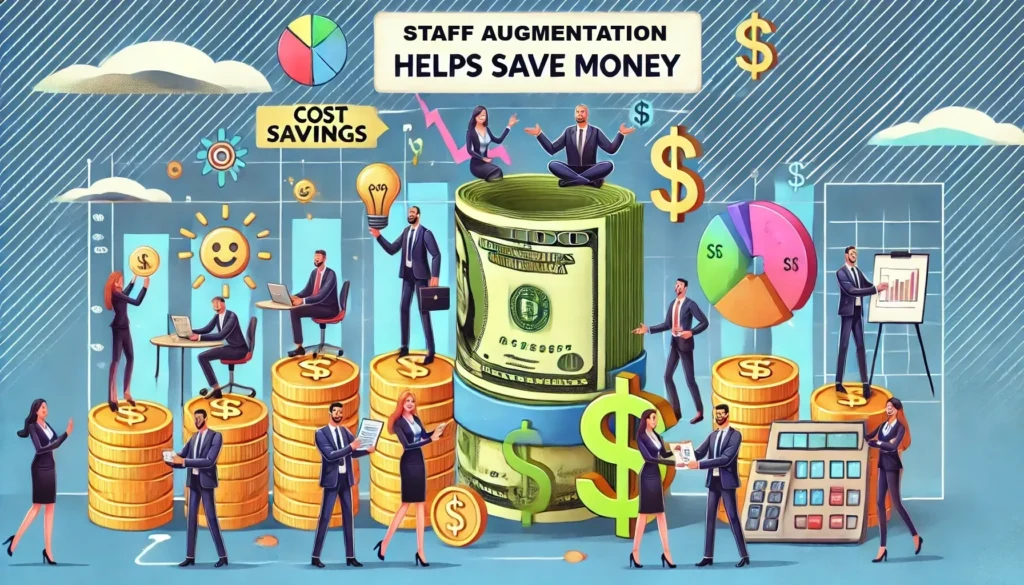A humanized guide to your staff augmentation journey

Finding the perfect development team can feel like chasing a unicorn. That's where IT staffing, or staff augmentation steps in – a lifeline for businesses like yours. Imagine effortlessly adding top-notch professionals to your team, just when you need them, without the hassle of traditional hiring. It's like having a secret weapon in your back pocket, ready to unleash when the project demands it.
Whether you're a nimble startup aiming for the stars, an outsourcing company looking to supercharge your services, or a corporate giant tackling massive IT projects, this guide is your compass. We'll walk you through the ins and outs of staff augmentation, sharing real-world strategies and expert advice. Our goal? To empower you with the knowledge to confidently navigate this exciting world, making choices that perfectly align with your unique goals.
What's in the box?
Together, we'll uncover the magic of IT staffing: what it is, why it's awesome, and how to conquer the challenges. We'll explore how it fits into the diverse landscapes of startups, enterprises, and everything in between. You'll discover crucial factors for success, from crafting a winning plan to finding the ideal partner and seamlessly integrating new talent. We'll even take a peek into the future, where cutting-edge trends are shaping the staff augmentation landscape.

Hiring in-house is far from staff augmentation
Each section of this guide acts as a doorway to deeper insights, leading you to detailed articles that dive into specific topics. So, think of this guide as your home base – a central hub where you can always find the answers you need to build a brilliant staff augmentation strategy. Let's embark on this journey together!
A humanized guide to your staff augmentation journey — you are here
Understanding the basics of staff augmentation
Definition and scope
Staff augmentation involves temporarily integrating external professionals into your existing team to meet specific project needs. Unlike outsourcing, where entire functions or projects are handed off to another company, staff augmentation keeps the management and oversight in-house.
This model allows you to scale your workforce quickly, bringing in specialized skills without the long-term commitment of hiring full-time employees. This approach is particularly beneficial for IT projects that require niche expertise or need to ramp up rapidly.
Advantages of staff augmentation
Flexibility. Indeed, one of the most significant benefits of staff augmentation is its flexibility. You can scale your team up or down based on project demands, ensuring you have the right skills at the right time. This adaptability helps manage costs and resources efficiently.
Cost-effectiveness. By avoiding the expenses associated with full-time employees, such as benefits, training, and long-term salaries, organizations can significantly reduce their operational costs. You only pay for the specific skills and duration needed.

Access to specialized skills. IT staffing provides access to a global talent pool, enabling you to bring in experts with specific technical skills that may not be available within your existing team. This is crucial for projects requiring advanced programming, cybersecurity, or emerging technologies like AI and blockchain.
Common challenges of staff augmentation
Integration issues. Integrating external professionals into your existing team can be challenging. Differences in work culture, communication styles, and processes can lead to misunderstandings and a lack of cohesion.
Cultural mismatches. Ensuring that augmented staff fit well with your company’s culture is essential for maintaining team dynamics and productivity. Cultural mismatches can hinder collaboration and affect overall team performance.

Management complexities. Managing a mixed team of internal and external staff requires clear communication, defined roles, and effective project management. Without these, the augmented staff might struggle to align with the project goals and timelines.
How we sourced data for the whole pillar cluster
When we set out to source data for the pillar-cluster content, we knew the best insights wouldn’t come from sterile reports but from real conversations happening in the trenches.
We sifted through discussions on Reddit, Quora, and Slashdot, where users shared their frustrations, challenges, and solutions. These platforms are rich with natural, unfiltered voices—people asking questions and sharing experiences that shine a light on the real problems businesses face with staffing, outsourcing, and IT services.
As a result, we grounded the content in the real struggles people face with staffing, outsourcing, and IT services, making sure our strategy speaks directly to their concerns. The quotes we gathered weren’t just filler; they became proof of the very problems our solutions are built to solve.
Reading the articles of this pillar cluster, you'll meet the quotes many times, right in the places where they appeal the best.
Reddit users don’t sugarcoat it — staffing and outsourcing can feel like walking into a minefield. Almost every story in the comments cuts to the chase: integration failures, cultural mismatches, and picking the wrong partner can blow up in your face.
Staff augmentation helps bring in the right skills when you need them and cut loose when you don’t, without the chains of long-term commitment. Just be ready to manage the balancing act — transparency and communication are your lifelines to keeping things from spiraling out of control.
Quora users lay it out bluntly: startups live or die by their hiring decisions, and if you're not smart, you'll be out of the game before you even get started. You need speed, flexibility, and a bit of cunning to attract talent without blowing your budget.
Yeah, staff augmentation looks glossy here too. But don't kid yourself — cultural fit and strong leadership aren’t just nice-to-haves; they’re the glue that keeps your team from falling apart at the seams when the going gets tough. Get it right, and you’ve got the foundation for innovation and growth.
On Slashdot, the mood’s a bit darker—tech workers swap war stories about a job market that’s become a battleground, where automation is chewing up opportunities faster than they appear.
In this chaos, staff augmentation emerges as a double-edged sword. On one side, it’s the answer for businesses needing niche skills fast and cheap. On the other, it can leave morale in the gutter if mishandled.
Staff augmentation across different IT ecosystems
IT staffing and startups
In IT startups, speed and agility are crucial. Therefore, staff augmentation plays a critical role in supporting rapid growth and scalability.
Startups often face fluctuating workloads and project demands. It makes it challenging to maintain a full-time team with all the necessary skills. By leveraging staff augmentation, startups can quickly fill skill gaps, manage resource constraints, and accelerate product development.
This approach allows startups to bring in specialized talent on a temporary basis. It's a way for them to meet project deadlines and innovate without the long-term financial commitment of hiring full-time employees.
Outsourcing companies
Outsourcing companies are continually looking to enhance service delivery and client satisfaction.
For this purpose, staff augmentation offers a flexible and efficient scaling solution based on client demands. Outsourcing firms that integrate them can quickly respond to new projects. showing the right expertise to meet client requirements.
This model also allows them to manage costs effectively, as they can scale their team up or down without the overheads associated with full-time hires. Additionally, staff augmentation helps outsourcing companies maintain a competitive edge by providing access to a global talent pool with diverse skills.
IT staffing and large enterprises
Large enterprises often manage extensive IT projects that require a broad range of skills and expertise. Strategic staff augmentation is essential for sustaining innovation and managing these large-scale projects. Thanks to external professionals, enterprises can ensure they have the necessary skills for specific project phases, such as system integration, data migration, or cybersecurity.
This approach also allows them to maintain operational efficiency by supplementing their existing team without the long-term costs of full-time employment. Furthermore, staff augmentation helps large enterprises adapt to changing market conditions and technological advancements by providing the flexibility to bring in experts as needed.

Indeed, each of these scenarios illustrates the diverse applications and benefits of staff augmentation across different IT ecosystems. Break this model down and analyze in detail, therefore enhance your operational efficiency, drive innovation, and achieve their strategic goals.
Key considerations for implementing staff augmentation
Strategic planning
Aligning staff augmentation with your overall business objectives is crucial for maximizing its benefits.
Start by identifying the specific needs of your projects and how temporary external expertise can fill these gaps.
Define clear goals and outcomes for augmented staff, ensuring their contributions directly support your strategic initiatives. After all, effective planning involves assessing your current team’s capabilities, forecasting future needs, and determining the optimal balance between internal and external resources.
Selecting the right partner
Choosing the right staff augmentation partner can significantly impact your project’s success. Key criteria for selecting a partner include their expertise in your industry, reliability, and cultural fit with your organization.
At first, you should look for partners with a proven track record, strong references, and the ability to provide the specific skills you need.
Additionally, consider their flexibility in scaling resources up or down based on project requirements and their processes for vetting and managing external professionals.
IT staffing integration strategies
Integrating augmented staff into your existing teams and workflows is indeed essential for maintaining productivity and cohesion. Start with a comprehensive onboarding program that familiarizes new team members with your company’s culture, values, and operational standards.
For this reason, pair augmented staff with in-house mentors to guide them through initial tasks and help them integrate smoothly into the team. Regular check-ins and clear communication protocols can address any integration issues and ensure that all your team members are aligned on project goals.
In fact, implementing staff augmentation effectively requires thoughtful planning and execution. Aligning this strategy with your business objectives, selecting the right partners, and, most important, ensuring seamless integration, you can leverage external expertise to enhance your projects and drive organizational success.
Future trends and innovations in IT staffing
Technological advancements
The impact of AI and machine learning on staff augmentation is profound. In fact, these technologies are revolutionizing the way companies identify, recruit, and manage augmented staff.
Therefore, AI-powered platforms can quickly match candidates with specific project needs, enhancing the speed and accuracy of the hiring process. In other words, machine learning algorithms analyze data from past projects to predict future staffing needs, optimizing resource allocation. Additionally, AI-driven tools facilitate the onboarding and integration process by providing personalized training modules and performance tracking.

Moreover, technologies like blockchain are enhancing the transparency and security of staff augmentation. Given that, blockchain can verify the authenticity and work history of augmented staff, reducing the risk of fraud. This technology also streamlines contract management, making it easier to handle payments and compliance in a secure, verifiable manner.
Regulatory and global market trends of IT staffing
Evolving regulations and global market trends are significantly influencing staff augmentation strategies. As remote work becomes more prevalent, there is an increasing focus on compliance with local labor laws and international regulations. So, you should always stay informed about changes in employment laws, data protection standards, and contractual obligations across different regions to avoid legal pitfalls.
Global market trends are also driving the demand for more diverse and inclusive workplaces. In reality, companies are leveraging IT staffing to bring in talent from various backgrounds, promoting diversity and fostering innovation.
As a result, this trend requires companies to implement inclusive hiring practices and create supportive environments for augmented staff from different cultural and professional backgrounds.
Additionally, the gig economy is reshaping the labor market, with more professionals opting for freelance and contract work. This shift is leading companies to adopt more flexible and adaptive staff augmentation models to attract top talent. Following these market dynamics and regulatory requirements is essential for developing effective staff augmentation strategies.
The future of IT staffing is being shaped by rapid technological advancements and evolving market dynamics. Therefore staying ahead of these trends and adapting to new innovations, organizations can leverage staff augmentation to drive growth, enhance efficiency, and remain competitive in a global marketplace.
Conclusion
Summing up, staff augmentation is your secret weapon for navigating the twists and turns of today's IT world. From scaling startups to conquering complex projects, this adaptable approach gives you the power to build the perfect team, exactly when you need it.
Ready to transform your workforce? Don't let talent shortages or project deadlines hold you back. Instead, take the leap and explore the possibilities of IT staffing.
Egor Kaleynik
IT-oriented marketer with B2B Content Marketing superpower. HackerNoon Contributor of the Year 2021 Winner – MARKETING. Generative AI enthusiast.
Featured in: Hackernoon.com, Customerthink.com, DZone.com, Medium.com/swlh
More info: https://muckrack.com/egor-kaleynik